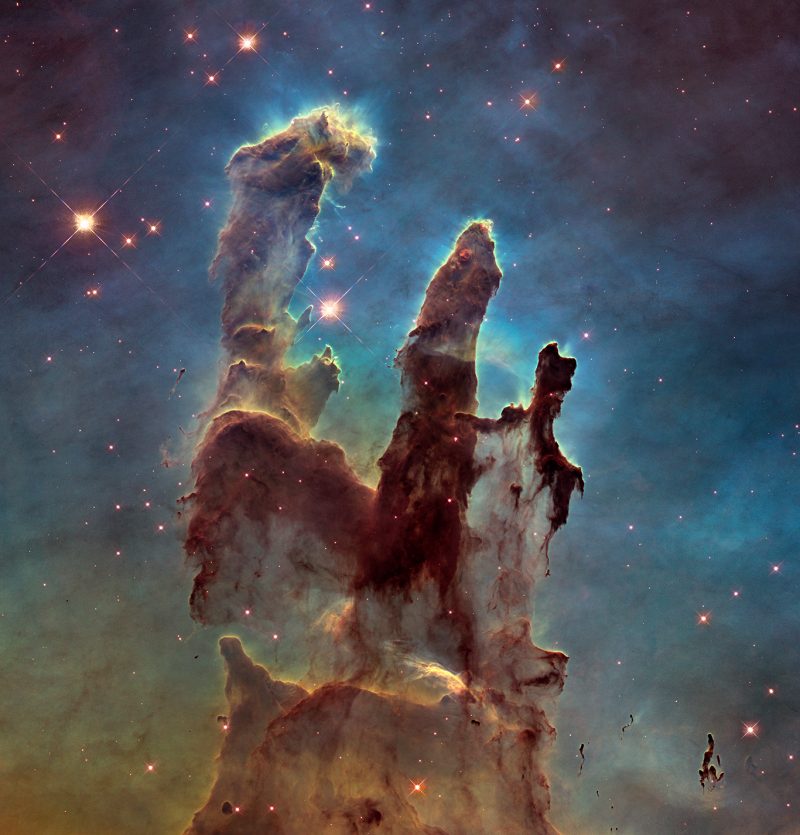The Awesome Beauty Of The Eagle Nebula

The Eagle Nebula, also known as Messier 16 or M16, is one of the most amazing sights you can see in a large telescope. It’s the location of several famous structures, including the stunning Pillars of Creation, a star-forming region, depicted in the image above. The Eagle Nebula contains not only the Pillars of Creation but several other star-forming regions as well. It also has many emission nebulae, or clouds in space that shine with their own light. And it has some dark nebulae. These are space clouds that don’t shine themselves, but that can be seen because they obscure light from shining objects located behind them.
The Eagle Nebula lies in the direction of the constellation Serpens the Serpent. It’s about 7,000 light-years away. And it’s visible in the sky on July and August evenings.
Take a look at the photos here to delve deeper into this region of space, which is one of the most interesting and beautiful we know.
Irregular red cloud of gas in a dense star field.
View larger. | The Eagle Nebula, aka M16. Photo via Martin MacPhee.
Reddish nebula in star field with oval yellow lines around two dark features and labels.
Labeled map showing both the Pillars of Creation and the Stellar Spire within the Eagle Nebula. Image via Martin MacPhee.
Like an eagle with outstretched wings
Jean-Philippe de Cheseaux is said to have “discovered” the Eagle Nebula in 1745-46. Afterwards, 18th century astronomers began including this object in their catalogs. With their early telescopes, the astronomers could see only the star cluster. And so this object was designated as M16 in Charles Messier’s catalog of things not to be confused with comets. Later, what astronomers thought was a simple open star cluster came to be known as a nebula, or cloud in space. They called it the Snow Queen Nebula.
Still later, the advent of astrophotography revealed a large area of glowing hydrogen gas that was invisible to the unaided eye. The nebula looked somewhat like an eagle with outstretched wings, giving rise to the current common name of Eagle Nebula.
Soon higher-resolution – clearer – photography, and then digital photography, began to reveal more and more features. In particular, astronomers began to notice the dark patches (aka dark nebulae) in the Eagle Nebula. That’s when many distinct features within the Eagle Nebula began to be given individual names. Today, the informal name of the Eagle Nebula is taken as referring to all of these in one collective designation.
Some of them are famous, and all are beautiful.
The Eagle Nebula suddenly burst upon the world’s collective consciousness in 1995, when the Hubble focused its attention on a dark nebula in the center of the Eagle, which you can see in the (updated) photo at the top of this post.
Star chart showing the Teapot, with an arrow drawn to M16 and M17.
It’s relatively easy to find M16 in your sky, if your sky is dark. Here’s how to star-hop from the famous Teapot asterism in the constellation Sagittarius to Messier 16 and Messier 17.
Iconic Pillars of Creation
The mesmerizing dark protrusions of dense gas were found to be the site of the formation of new stars and solar systems. Known as the Pillars of Creation, this photograph gave most people their first view of newly born stars and solar systems at the dawn of their creation. The Pillars of Creation are immense, about 4 to 5 light-years tall. The Eagle Nebula itself spans about 70 by 55 light-years.
Similar areas, such as the Stellar Spire on the left side of the Eagle, are also forming new stars through a combination of processes. The cold, mostly hydrogen gas of the nebula has already fueled the formation of a series of young, hot stars. As the gas continues to collapse under its own gravity into the dark forms we see, new stars and solar systems form and continue to grow as they attract more and more gas to them. However, the intense light pressure from the new stars that have formed and their solar winds are eroding away the dense, cold gas pockets, diminishing new star formation and dispersing the nebulae.
At the same time however, the shock waves, where the light and solar wind impact the cold gas, heat and compress some of the cold gases at the same time, resulting in a new set of star forming environments.



 Creators of mankind
Creators of mankind Description of “Tall white aliens”
Description of “Tall white aliens” Where they came from?
Where they came from? About hostile civilizations
About hostile civilizations The war for the Earth
The war for the Earth “Tall white aliens” about eternal life
“Tall white aliens” about eternal life Video: “Nordic aliens”
Video: “Nordic aliens” Aliens
Aliens Alien encounters
Alien encounters The aliens base
The aliens base UFO
UFO Technology UFO
Technology UFO Underground civilization
Underground civilization Ancient alien artifacts
Ancient alien artifacts Military and UFO
Military and UFO Mysteries and hypotheses
Mysteries and hypotheses Scientific facts
Scientific facts


















